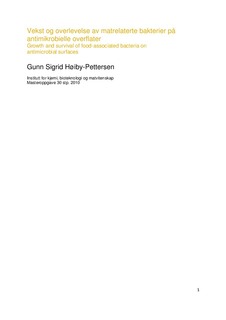Overlevelse og vekst av matrelaterte bakterier på antimikrobielle overflater
Master thesis
Permanent lenke
http://hdl.handle.net/11250/186297Utgivelsesdato
2010-10-29Metadata
Vis full innførselSamlinger
- Master's theses (KBM) [890]
Sammendrag
Det er de siste årene kommet en rekke produkter på markedet med påståtte antimikrobielle
egenskaper, der antimikrobielle forbindelser er inkorporert i eller ligger som belegg utenpå
produktet. To slike antimikrobielle forbindelser er triclosan og nanosølv. Begge forbindelsene
finnes i en rekke kommersielle produkter for eksempel såpe, kremer, tannkrem og
husholdningsprodukter som skjærebrett. Hensikten med disse undersøkelsene var å undersøke
om skjærebrett som inneholdt henholdsvis triclosan og nanosølv, hadde antimikrobiell effekt
på matrelaterte bakterier. Undersøkelsene omfattet kontroll av overlevelse og vekst av
bakterier på disse skjærebrettene, undersøkelse av MIC for de antimikrobielle forbindelsene i
ulike bakteriesuspensjoner og agadiffusjons-assay av de ulike typene skjærebrett.
Kuponger av skjærebrettene med bakteriesuspensjon som ble undersøkt ble inkubert ved
henholdsvis 70 og 100 % relativ fuktighet. MIC for triclosan og sølv ble undersøkt i
mikrotiter brett med samtlige enkelt stammer. Agardiffusjonsforsøket ble først gjort på
kuponger av samtlige materialer med bakteriesuspensjoner av fem overnattkullturer. Deretter
ble kupongen med triclosan undersøkt ved agardiffusjons-assay mot samtlige enkelt stammer.
Bakteriegruppene som ble benyttet var E. coli, Salmonella, Serratia, koagulase negative
Staphylococcus sp., St. aureus og L. monocytogenes. Resultatene viste at ingen kuponger med
nanosølv hemmet veksten, men på kupongen med triclosan kunne effekt sees ved 70 % relativ
fuktighet. Nanosølv var ikke tilgjengelig da MIC skulle undersøkes, sølvnitrat ble i stedet
benyttet. Alle benyttede stammer med få unntak fikk MIC for sølvnitrat 15,63 ppm. Tre L.
monocytogenes stammer og en Serratia stamme fikk MIC 31,25 ppm AgNO3. Resultatene
etter undersøkelsene av MIC for triclosan ga større variasjon mellom bakteriegruppene. Det
kunne i tillegg observeres små forskjeller innad i de ulike bakteriegruppene. Resultatene av
agardiffusjonsforsøket hvor samtlige materialer ble testet mot hver bakteriegruppe viste at kun
materialet med triclosan ga hemmesone. Hver enkelt stamme ble derfor undersøkt ved
agardiffusjons-assay mot dette materialet, og samtlige stammer ble hemmet og det kunne
observeres hemmesone med unntak på skåler med Serratia sp. Resultatene av MIC
undersøkelsene for triclosan og agardiffusjons-assay med materiale med triclosan samsvarte
nokså godt.
Tre kuponger av materialet med triclosan ble i tillegg undersøkt for virkning etter omfattende vask. Disse tre kupongene ble vasket nesten hver dag i to måneder i en husholdnings
vaskemaskin. Agardiffusjons-assay av disse kupongene mot ubehandlede kuponger av samme
type viste en signifikant forskjell på hemmesonenes størrelse, noe som tyder på at materialet
over tid vil miste sin virkning på grunn av vask og slitasje. ABSTRACT
Over the last years a large range of products with alleged antimicrobial effect have been
developed and are available on the market. The antimicrobial agents are incorporated
throughout the material or coating covering the product. Two such agents are triclosan and
nanosilver particles. These antimicrobial agents can be found in products like soaps, lotions,
toothpaste and different household products like cutting boards. The purpose of this research
was to investigate the antimicrobial effect of cutting boards incorporated with triclosan or
nanosilver. The research included testing of growth and survival of food-associated bacteria
on the cutting boards, test of MIC for the antimicrobial agents in different bacteria
suspensions and agardiffusion-assay of the different cutting boards.
The cutting boards were cut into coupons. Bacteria suspension were added to the coupons and
incubated in atmospheres with 70 and 100 % RH. The triclosan and nanosilver’s MIC was
tested using microtiter plates for each strain. The agardiffusion-assay was first done with all
the materials using bacteria suspensions with five bacteria strains, followed by agardiffusionassay
with the triclosan containing coupon against each strain. Strains of E. coli, Salmonella,
Serratia, coagulase-negative Staphylococci, St.aureus and L. monocytogenes were used. The
results showed that none of the coupons incorporated with nanosilver inhibited the bacteria
growth, but the triclosan containing coupon showed effect in atmosphere with 70 % RH.
Nanosilver was not accessable when the MIC was tested and silver nitrate was used as a
substitute. All bacteria strains with a few exceptions got a MIC of 15,63ppm silver nitrate.
Three strains of L. monocytogenes and one strain of Serratia got a MIC of 31,25ppm silver
nitrate. The MIC-testing results of triclosan varied more for the different bacteria groups and
also showed some small variation between strains of the same species. In the agardiffusionassay
done with bacteria suspensions, only the coupon with triclosan gave inhibition rings.
Each strain was therefore tested against this coupon, and all strains were inhibited except the
five Serratia strains. The results of triclosan MIC testing and agardiffusion-assay with the
Microban coupon showed compliance.The antimicrobial effect of three coupons with triclosan
was tested using agardiffusion-assay after an extensive washing. The coupons had been
washed in a household dishwasher nearly every day for two months. The agardiffusion-assay
showed that the washing had effected their antimicrobial effect significantly, indicates that the
material will lose its effect due to washing and wearing.
